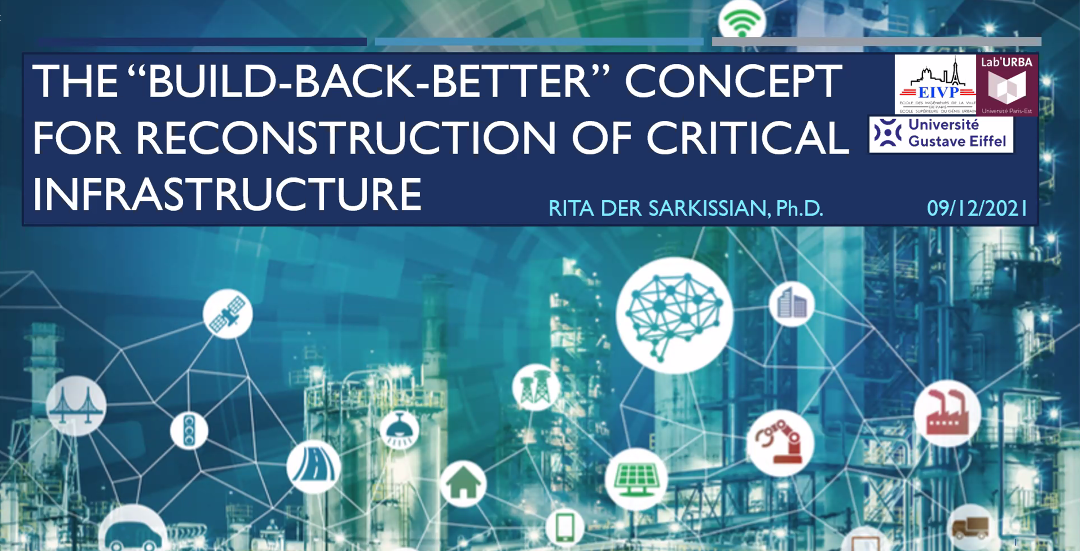As Prof. Youssef Diab (Université Gustave Eiffel) is piloting a civil engineering master course at the University of Liège, a webinar on "Urban Resilience" has been organized for about 15 specialized engineering students on the 9th of December 2021 at 1.45 pm (CET). It gathered 3 different speakers, with 3 different backgrounds and experiences.Pilot4DEV has presented the CRIC (Climate Resilient and Inclusive Cities) project of which both the Université Gustave Eiffel and Pilot4DEV are partners.
Rita Der Sarkissian (PhD), a researcher specialized in demo-sensing, GIS as well as urban engineering, gave a presentation on the concept of “Building Back Better (BBB)”.
Disaster risk reduction (DRR) encompasses 4 distinct phases – prevention and mitigation as well as preparedness belong to the pre-disaster management while response and rehabilitation belong to the post-disaster management.
Building back better relates to a post-disaster recovery meant to avoid previous vulnerabilities and improve future resilience. Rita Der Sarkissian questioned the vagueness of the word “better” that can encompass various substances:
- (1) Recovering the functionality of infrastructures and make them more resilient to future disturbances,
- (2) Building Back Greener, disturbances are then an opportunity to achieve environmental sustainability and fight against climate change
- (3) Implementing a people-oriented reconstruction with improved, optimized and modernised services.
This concept is highly dependent on the context (disasters’ intensity and damages, the state of pre-disaster infrastructures, social capital, wealth and development…), the organizational structure (the networks of stakeholders – governments, experts, NGOs, citizens…), the resources available as well as a temporal dimension.
The various dimensions of Building Back Better have been highlighted through the example of Saint Martin’s island following Irma hurricane in 2017. In that case transports, telecommunications, water systems or again electricity have been affected. An example of Building Back Better can be seen in the electric network that came from an overhead level to an underground one, which made it more robust, safer, more aesthetic, allowing wider circulation spaces and that optimized the quality of the service.

@ Rita Der Sarkissian's presentation
Ignasi Fontanals (Director Europe, Rezilio Technologie) highlighted the specific History of Barcelona (Spain) from a political stand. Barcelona went from a city facing numerous urban planning challenges to a model of resilience in Europe.
Ignasi Fontanals adressed 30 years of city management, mayor by mayor.
Barcelona is a very compact city between two rivers and next to the mountains that accommodates a wide range of activities from industrial areas to tourism. It benefited from the opportunity presented by the Olympics as a way to rebuild the city as much as it has been stimulated by strong impacts of natural hazards like the storm that destroyed la Rambla in the 1990’s.
Between 1982 and 1997 Pascual Maragall invested in critical infrastructures. This went through the investment in smart flooding management as well as technical networks coordination to allow a dissemination of the maps of the city between all the private actors having an impact on the public sphere. Joan Clos (1997-2006) has built a huge waste water treatment plan at the occasion of the Forum 2004 Event. Jordi Hereu (2006-2011) created the Security Service Supply – a public service for electricity in case of blackout. He also worked on a holistic approach connecting stakeholders (administrations, private sector actors…). Between 2011 et 2015, Xavier Trias built on his predecessors to create a platform to deal with city management and standards of resilience for cities. Ada Colau (2015 – Now) opted for a social resilience, emphasizing the importance of social services, opening the scope of resilience to social services but also environmental stakes.

@ Ignasi Fontanals' presentation - "Continuous improvement towards urban resilience"
Resilience is a never-ending process relying on disturbances but also a strong political will.
Some projects try to implement mechanisms of resilience. This is the sense of the CRIC (Climate Resilient and Inclusive Cities) project which was presented last but not least.

@ Pascaline Gaborit's presentation - key strategies in implementing urban resilience projects
Pascaline Gaborit PhD. (Director of Pilot4DEV) explained that this 5-years project funded by the European Union was intended to answer the challenge of climate adaptation in South East Asia where there is a high vulnerability to natural hazards coupled with infrastructure challenges. Pascaline Gaborit highlights how fundamental is the understanding of the interrelations and complexity of risks, exposure and solutions.
Therefore, the project started by carefully identifying priorities on the field to select adequate tools to implement based on the work of local experts.
Through the examples of 5 Indonesian cities (Banjarmasin, Samarinda, Mataram, Ternate, Pangkalpinang), Pascaline Gaborit explained how different priorities and stakes can be depending on various physical, political and socio-economic parameters, and so how different the solutions proposed for each city are.
Key strategies to implement an efficient urban resilience relate to:
- (1) An essential multi-stakeholders cooperation
- (2) The integration of multi-risks analyses
- (3) A work with local communities to answer their needs properly
- (4) The need for an adaptative design
- (5) A work with smart technologies on Early Warning Systems (EWS)
- (6)The questions of financing and accountability are essential (the role of cities and complex governance systems)
"The needs are tremendous and urgent."
This webinar was intended to provide the audience with 3 different and specialized approaches of urban resilience - a scientific and technical approach, a political and historical stand from a European country, and the context of South East Asia under the concrete example of international cooperation - and this is exactly what it has accomplished. This online dialogue has sparked a few interesting comments notably on the role of political will in implementing urban resilience or the financing processes, specifically in the case of international cooperation.
It has been a dense and important event that hopefully provided specialized knowledge and broad perspectives to the civil engineers students of the University of Liège.

